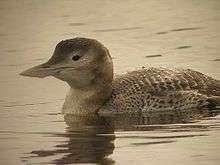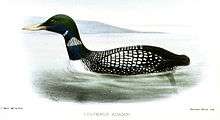Yellow-billed loon
| Yellow-billed loon | |
|---|---|
 | |
| Immature | |
| Scientific classification | |
| Kingdom: | Animalia |
| Phylum: | Chordata |
| Class: | Aves |
| Order: | Gaviiformes |
| Family: | Gaviidae |
| Genus: | Gavia |
| Species: | G. adamsii |
| Binomial name | |
| Gavia adamsii (Gray, 1859) | |
 | |
| Range of G. adamsii Breeding range Wintering range | |
The yellow-billed loon (Gavia adamsii), also known as the white-billed diver, is the largest member of the loon or diver family. Breeding adults have a black head, white underparts and chequered black-and-white mantle. Non-breeding plumage is drabber with the chin and foreneck white. The main distinguishing feature from great northern loon is the longer straw-yellow bill which, because the culmen is straight, appears slightly uptilted.
It breeds in the Arctic and winters mainly at sea along the coasts of the northern Pacific Ocean and northwestern Norway; it also sometimes overwinters on large inland lakes. It occasionally strays well south of its normal wintering range, and has been recorded as a vagrant in more than 22 countries. This species, like all divers, is a specialist fish-eater, catching its prey underwater. Its call is an eerie wailing, lower pitched than the common loon.
Taxonomy and etymology

First described by English zoologist George Robert Gray in 1859 based on a specimen collected in Alaska, the yellow-billed loon is a monotypic species, with no subspecies despite its large Holarctic range.[2] It is closely related to the common loon, which it strongly resembles in plumage and behaviour; some taxonomists consider the two species to be allopatric forms of the same superspecies. Both are thought to have evolved from a population of black-throated loons which colonized the Nearctic and were subsequently cut off from other populations.[3]
The genus name Gavia comes from the Latin for "sea mew", as used by ancient Roman naturalist Pliny the Elder. The specific epithet adamsii honours Edward Adams, a British naval surgeon and naturalist who sketched and collected numerous species, including this one,[4] on several trips to the Arctic.[5] The word "loon" is thought to have derived from the Swedish lom, the Old Norse or Icelandic lómr, or the Old Dutch loen, all of which mean "lame" or "clumsy", and is a probable reference to the difficulty that all loons have in moving about on land.[6] "Diver" refers to the family's underwater method of hunting for prey, while "yellow-billed" and "white-billed" are references to the bird's distinctively pale bill.[5]
Description
With a length of 76 to 97 cm (30 to 38 in), a wingspan of 135 to 160 cm (53 to 63 in), and a weight ranging from 4 to 6.4 kg (8.8 to 14.1 lb), the yellow-billed loon is the largest member of the loon (diver) family.[2][7][8] The adult is primarily black and white in breeding plumage, with a purple gloss on its head and neck.[9]
Habitat and range
The yellow-billed loon is an Arctic species, breeding primarily along the coasts of the Arctic Ocean as far north as 78° N and wintering on sheltered coastal waters of the northern Pacific Ocean and the northwestern coast of Norway.[2] It has been recorded as a breeding bird in Russia, Canada and the United States.[1] Though it winters primarily to the north of 50° N, its winter range extends south to 35° N off the coast of Japan,[2] and it has been recorded as a vagrant in more than 20 countries,[1] including some as far south as Mexico[10] and Spain.[1]
Behaviour
Breeding
Like other loons, it forms long-lasting pairs. Though it prefers freshwater pools or lakes in the tundra, the yellow-billed loon will also breed along rivers, estuaries or the coast in low-lying areas of the Arctic; in general, it avoids forested areas. Breeding typically starts in early June, though it is dependent on the timing of the spring thaw. Like all members of its family, the yellow-billed loon builds a nest of plant material very close to the edge of the water. The female lays two eggs. Copulation takes place on land, without any specific courtship. The pair defends its large territory intensively against intruders, but may later in the breeding season gang up with other birds on good fishing spots.[2]
Feeding
The yellow-billed loon is a specialist fish eater, though it also takes crustaceans, molluscs and annelids. It dives in pursuit of prey, which is caught underwater.[2] Probably as a way to avoid spreading parasites, it defecates ashore, in the breeding lake.
Conservation and threats
In 2010, the IUCN (International Union for the Conservation of Nature) changed the status of the yellow-billed loon from Least Concern to Near Threatened, as the species appears to be in a "moderately rapid" population decline. An unsustainable level of subsistence harvesting by indigenous peoples was specifically named as the main threat.[1]
The yellow-billed loon is one of the species to which the Agreement on the Conservation of African-Eurasian Migratory Waterbirds (AEWA) applies;[11] in the Americas, it is protected by the Migratory Bird Treaty Act of 1918.[12]
References
Citations
- 1 2 3 4 5 BirdLife International (2012). "Gavia adamsii". IUCN Red List of Threatened Species. Version 2013.2. International Union for Conservation of Nature. Retrieved 26 November 2013.
- 1 2 3 4 5 6 Carboneras 1992, p. 172
- ↑ Carboneras 1992, p. 162
- ↑ Johnsgard, Paul A. (1987). "Diving Birds of North America: Appendices". University of Nebraska, Lincoln. p. 265. Retrieved 6 March 2010.
- 1 2 Holloway, Joel Ellis (2003). Dictionary of birds of the United States: Scientific and Common Names. Portland, OR, USA: Timber Press. p. 99. ISBN 0-88192-600-0.
- ↑ Carboneras 1992, p. 169
- ↑ "Yellow-billed Loon". eNature.com. 2011. Archived from the original on 16 January 2010. External link in
|website=(help) - ↑ Dunning Jr., John B., ed. (1992). CRC Handbook of Avian Body Masses. CRC Press. ISBN 978-0-8493-4258-5.
- ↑ Cramp 1977, p. 62
- ↑ Howell, Steve N.G.; Webb, Sophie (1995). A Guide to the Birds of Mexico and Northern Central America. Oxford University Press. p. 93. ISBN 0-19-854012-4.
- ↑ "Waterbird species to which the Agreement applies" (PDF). Agreement on the Conservation of African-Eurasian Migratory Waterbirds. p. 22. Retrieved 18 December 2014.
- ↑ "Birds Protected by the Migratory Bird Treaty Act". US Fish and Wildlife Service. Retrieved 6 March 2011.
Bibliography
Sjölander, Sverre. The reproductive Behavior of the Yellow-billed Loon, Gavia adamsii. (With G. Ågren). The Condor 78:454-463. 1976.
Further reading
- Carboneras, Carles (1992). "Family Gaviidae (Divers)". In del Hoyo, Josep; Elliott, Andrew; Sargatal, Jordi. Handbook of the Birds of the World. Volume 1: Ostrich to Ducks. Barcelona: Lynx Edicions. pp. 162–172. ISBN 84-87334-10-5.
- Cramp, Stanley, ed. (1977). "Gavia adamsii White-billed Diver". Handbook of the Birds of Europe, the Middle East and North Africa: Birds of the Western Palearctic. Volume 1, Ostrich to Ducks. Oxford University Press. pp. 62–64. ISBN 0-19-857358-8.
- Sjölander, Sverre; Ågren, Greta (1976). "The reproductive Behavior of the Yellow-billed Loon, Gavia adamsii". The Condor. 78 (4): 454–463. doi:10.2307/1367094.
Identification
- Appleby, R.H.; Madge, S.C.; Mullarney, Killian (1986). "Identification of divers in immature and winter plumages". British Birds. 79 (8): 365–391.
External links
| Wikimedia Commons has media related to Gavia adamsii. |
| Wikispecies has information related to: Gavia adamsii |
- Flicker Field Guide Birds of the World Photographs
- BirdLife species factsheet for Gavia adamsii
- "Gavia adamsii". Avibase.

- "White-billed diver media". Internet Bird Collection.
- Yellow-billed loon photo gallery at VIREO (Drexel University)
- Audio recordings of Yellow-billed loon on Xeno-canto.
